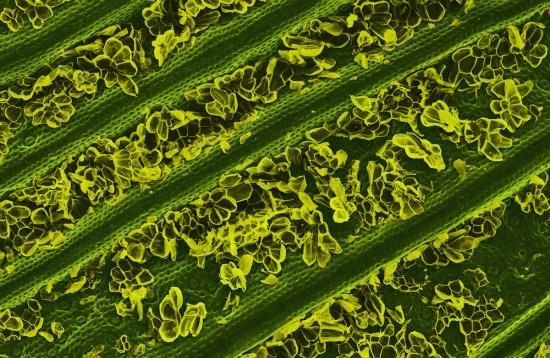A Closer Look at What You Eat
A photographer uses a scanning electron microscope to zoom in on everyday foods—and makes art
/https://tf-cmsv2-smithsonianmag-media.s3.amazonaws.com/filer/20120113010034Alpert_terra_cibus_no_4_fortune_cookie-homepage.jpg)
San Francisco-based photographer Caren Alpert has captured mouth-watering shots of food, stylish portraits of chefs and glimpses of chic restaurant interiors for clients such as Bon Appetit, Saveur Magazine and the Food Network. But, beginning in 2008, she branched out from her editorial and catalog work to experiment in fine art.
Alpert has taken magnified photographs of foods, from Brussels sprouts to Lifesavers, using a scanning electron microscope at her alma mater, the University of Arizona. Titled “Terra Cibus,” meaning “nurturing from the earth,” the series, recently exhibited at the James Beard Foundation in New York, provides viewers a new, and often bizarre, look at familiar foods.
I spoke with Alpert about the project:
Can you describe the process of preparing the samples and getting the shot?
I choose the foods out here in San Francisco. I sort of curate them if you will. I decide what I want to shoot. I overnight them to the lab in Arizona. They go through a dehydration process and then a metal coating process. Depending on what the food is, the length of dehydration can yield a better result and different metals used in the coating can yield a different result. That is the preparation process.
With a scanning electron microscope you are photographing the surface of a subject or a specimen—in my case, food. I am basically photographing the electrons bouncing off of the surface.
What have been the most interesting foods under the microscope?
The sugar and the salt for sure. I like the kiwi seeds. I love the pineapple leaf (below).
Have you gotten a sense of which foods are photogenic under the microscope and which are not?
I am getting better. But I wouldn’t say I am dead on 100 percent of the time.
I read that you tried a tortilla chip and it was boring looking. Have there been other duds?
Interestingly, it has been difficult to photograph meats and proteins. Bacon, for example—I thought it would be more interesting than it was at first pass. I am trying to find the best way to photograph foods like that, that are higher in fats.

What sort of editing do you do?
The machine captures in black and white only. We do a post-processing treatment back at the studio where we infuse the color of the original foods as best we can.
After photographing a shrimp tail, you went to a scientist at the Monterey Bay Aquarium to inquire about its feathery texture. Do you often take your photographs to outside experts?
Certainly when I am stumped, yes. I am trying to involve more information about what we are looking at. The shrimp tail was quite surprising. Because the Monterey Bay Aquarium is a local gem for us, it was nice to be able to call on them, and they were very receptive to helping out. They were also very surprised to see the image. That is the part of the tail where you hold it and bite it off and then you throw the tail back on your plate. It is right there at that sort of cartilagey intersection.
What have you learned about food from these photographs?
How an unprocessed food or an organic food intakes water or air, you see a lot of that. Processed foods are very sharp and spiky, whereas unprocessed or more organic foods sort of have a repetitive pattern.
Has working on this series changed your own eating habits in any way?
No. Probably the biggest shock—but it hasn’t been enough to change my eating habits—is the French’s fried onions, which you sprinkle over your string bean casserole. They are really irregular and very violent looking compared to some of the others. You would think after seeing it, it would be enough to make you not want to eat them. But they are sort of a guilty pleasure. I snack on those occasionally.
Is healthy eating part of the goal? What do you hope viewers take away from the photographs?
I hope the viewers think about their own choices everyday or how they influence others around them. I got an email a few months ago from a man who said he and his two kids were on my website trying to guess all the foods. Then they would go back to their kitchen cupboards or refrigerator drawers to see if they had any of those foods at home. I think if it can encourage dialogue like that it is really interesting and successful.
I sort of like to encourage the viewer to look at it more aesthetically. I think people are so floored. “Oh my gosh, that is my lunch sandwich or that is my chocolate cake or that is my morning blueberries.” People are just fascinated. They are taken with the beauty of some foods and not others, of course. I got another email from a young woman in Spain who said that she and her boyfriend were fighting about images as art. She thought the images were beautiful and artistic, and he thought, oh, anyone can do that. They were having an argument about what makes art. That’s awesome, you know? It is really encouraging people to think about the parameters they put around those definitions.
More images can be seen at www.carenalpertfineart.com. Prints are available for purchase directly through the photographer.
/https://tf-cmsv2-smithsonianmag-media.s3.amazonaws.com/accounts/headshot/megan.png)
/https://tf-cmsv2-smithsonianmag-media.s3.amazonaws.com/accounts/headshot/megan.png)